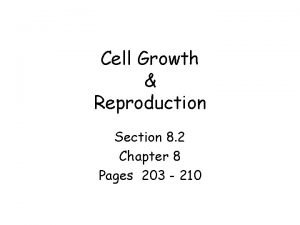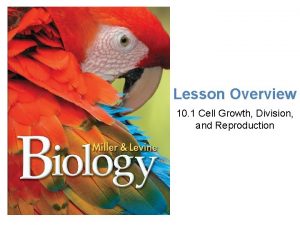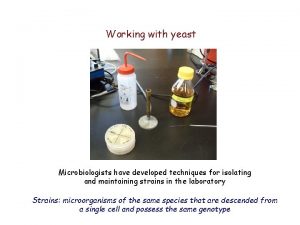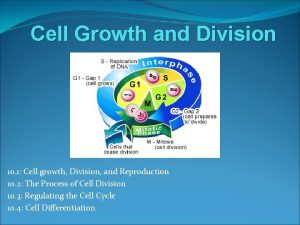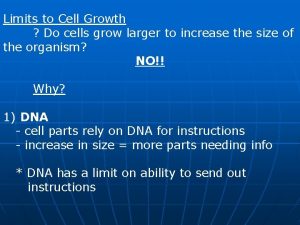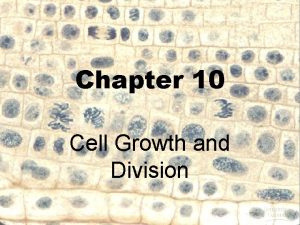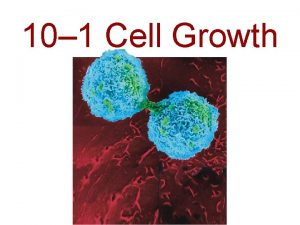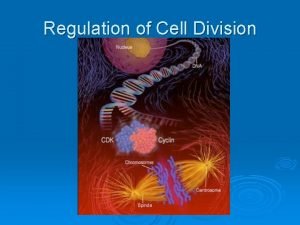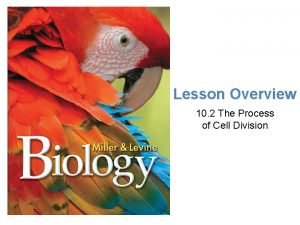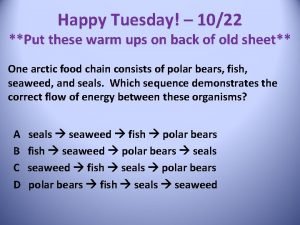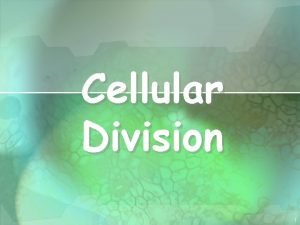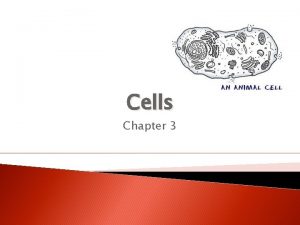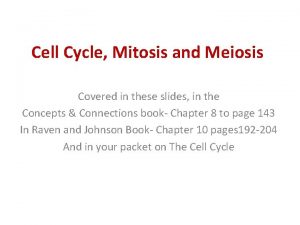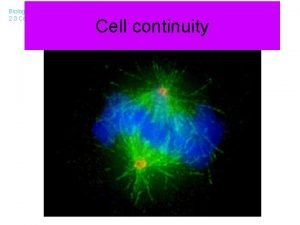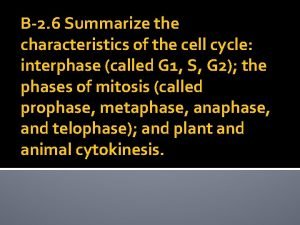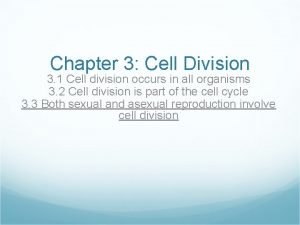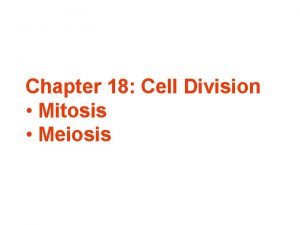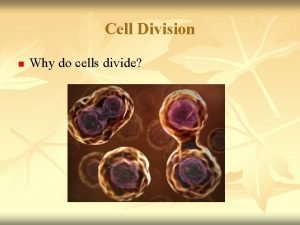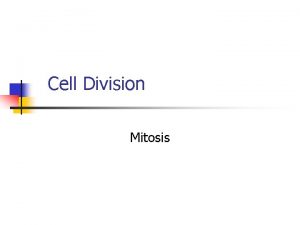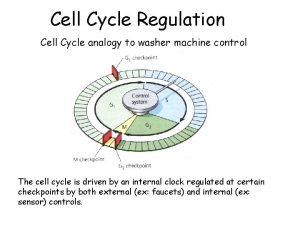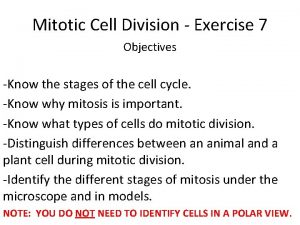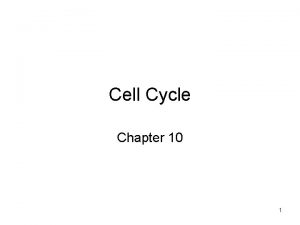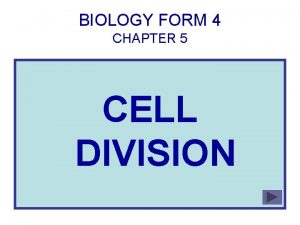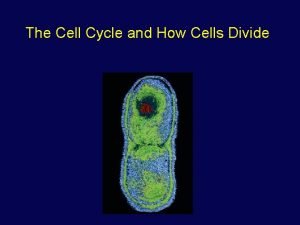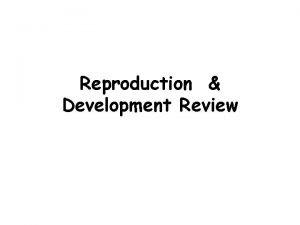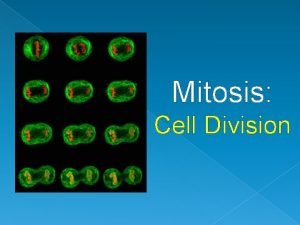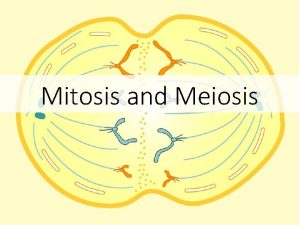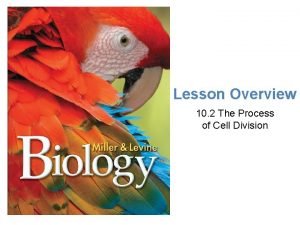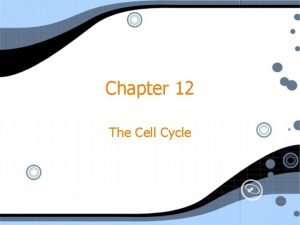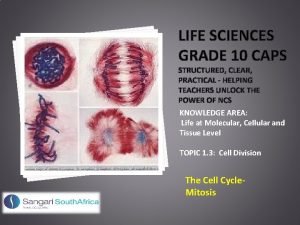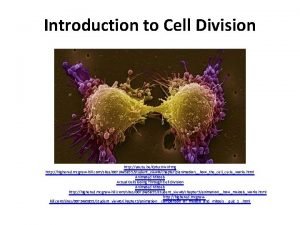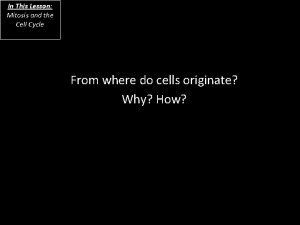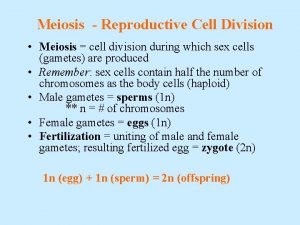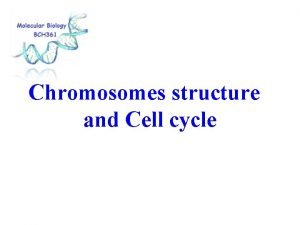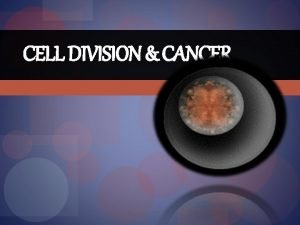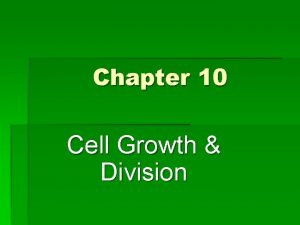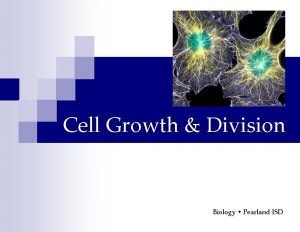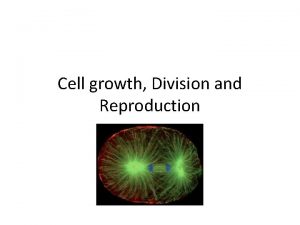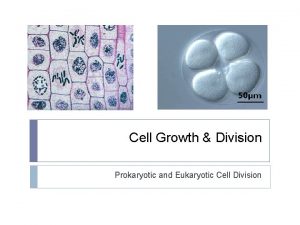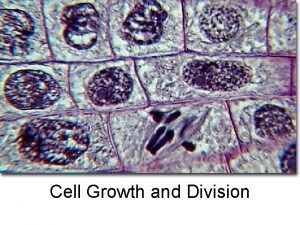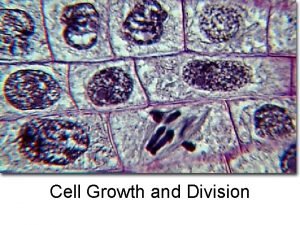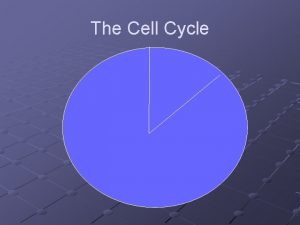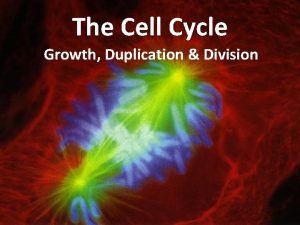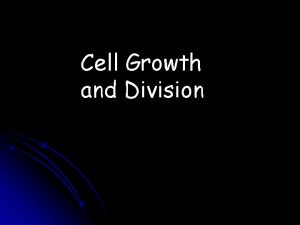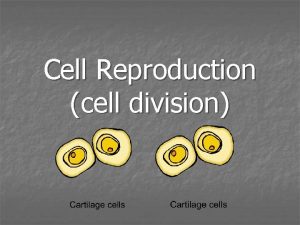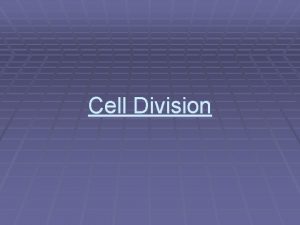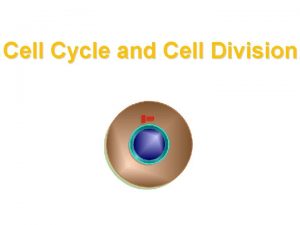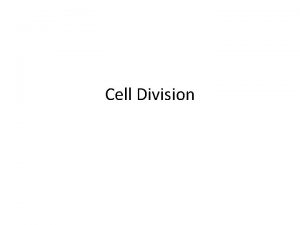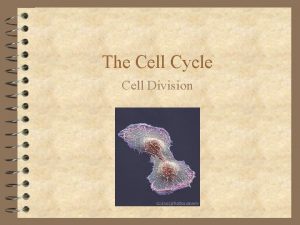Topic 4 Cell Growth Division Chapter 10 The


























































































- Slides: 90

Topic 4 Cell Growth & Division Chapter 10: The Cell Cycle and Mitosis BIOLOGY- WAUGAMAN - LATHROP

Twilight Mitosis • https: //www. youtube. com/watch/? v=s. OM_u 1 PY 0 s 0

10. 1 Cell Growth, Division, and reproduction Limits to Cell Size • Cells come in all shapes and sizes…the smallest are bacteria cells…the largest is the ostrich egg…. …the largest human cell is the female egg

10. 1 Cell Growth, Division, and reproduction Factors Affecting Cell Size Three things that limit cell size: 1. Rate of Diffusion 2. Amount of DNA 3. Surface Area-to-Volume ratio of cell

10. 1 Cell Growth, Division, and reproduction 1. Diffusion Limits Cell Size • Nutrients, oxygen, water & wastes must pass through the membrane efficiently. • Diffusion is fast and efficient over a short distance. – Slow and inefficient as distance becomes greater. • Because of the slow rate, organisms cannot be just one giant cell. The organelles would “starve” waiting for necessary nutrients to “diffuse“ to them, and wastes would build up in the cell.

10. 1 Cell Growth, Division, and reproduction 2. DNA Limits Cell Size • We talked about how the nucleus contains the code or blueprints for proteins. . . • Proteins are used throughout the cell to perform various cell functions. • There’s a limit to how fast the nucleus can instruct the ribosomes to make the proteins. • The cell cannot survive unless there is enough DNA to support the protein needs of the cell. I Love Lucy Chocolate Factory

10. 1 Cell Growth, Division, and reproduction 3. Surface Area to Volume Ratio • As a cell’s size increases, its volume increases much faster than its surface area. • Increased volume means the cell needs more nutrients and produces more waste • However, if the surface area does not increase relative to the volume, the surface area cannot support the volume’s needs… and the cell will die!

10. 1 Cell Growth, Division, and reproduction DNA Structures of Cell Cycle • Chromatin – long, uncoiled strands of DNA…this is the DNA structure during most of the cell’s life. • Chromosomes – Tightly coiled structure of DNA, forms before cell replication. • Carries the genetic material (DNA) that is copied and passed from generation to generation of cells. • This genetic material is crucial to the identity of the cell. Chromatin Chromosomes

10. 1 Cell Growth, Division, and reproduction DNA Structures of Cell Cycle • Sister Chromatids – 2 halves of the duplicated chromosomes. • Sister chromatids and the DNA they contain are exact copies of each other. • They are formed when DNA is replicated (copied) during interphase • Centromere – a protein structure that holds the two sister chromatids together. • Plays a role in chromosome movement during mitosis. sister Centromere

10. 1 Cell Growth, Division, and reproduction Purpose of Sister Chromatids • Before Cell Replication the cell COPIES all the strands of DNA in the nucleus. • All the strands of DNA now coil up to form chromosomes • The copies for each chromosome are “tied” together by the centromere. – Why copy DNA? – Why does DNA coil into a chromosome? – Why tie together copies? – Cast away

10. 1 Cell Growth, Division, and reproduction Chromosome Numbers • Organism with most chromosomes is a fern with 630 different chromosomes. – 2 n =1, 260 strands of DNA • Humans have 23 pairs of chromosomes. – Haploid (1 n) = 23 different chromosomes – Diploid (2 n) = 23 pair = 46 chromosomes – 23 chromosomes from mom and 23 chromosomes from dad

10. 1 Cell Growth, Division, and reproduction The Cell Cycle • The series of events that occurs during the life of a cell is called the Cell Cycle. • Why Do Cells Divide? • Reproduction • Growth • Repair

10. 2 The Process of cell Division Stages of Cell Cycle • Interphase • • Prophase Metaphase Anaphase Telephase Phases OF MITOSIS • Cytokinesis – IPMAT

10. 2 The Process of cell Division INTERPHASE – not very “interesting” • Interphase is when a Cell is in a “working” phase, performing normal cell functions (metabolism) • At the end of Interphase Organelles (including the chromosomes) double in number, to prepare for division.

10. 2 The Process of cell Division INTERPHASE • Longest part of the cell cycle…broken into Stages: • G 1 (Growth 1) - The cell grows in size • S (Synthesis) – DNA copies • G 2 (Growth 2) – Cell prepares for division

10. 2 The Process of cell Division Cell in Interphase • Normal metabolic activities • DNA is chromatin • Nuclear Membrane Present

10. 2 The Process of cell Division Mitosis – Cell Division • Process by which a Somatic (BODY) cell divides into 2 identical daughter cells. • Each new cell has a complete set of chromosomes. Why is this important? • In nuclear division (MITOSIS), the number of chromosomes remains the same. Why is this important? • Phases of Mitosis: 1. Prophase 2. Metaphase 3. Anaphase 4. Telophase

10. 2 The Process of cell Division Summary of Mitosis Cytokinesis • One parent cell divides to create 2 daughter cells that are identical in DNA and Function as the original cell. This Organism’s Cells have 2 different Chromosomes

10. 2 The Process of cell Division Mitosis - #1 PROPHASE Events & Structures in Prophase: 1. Spindle fibers form “Protein Ropes” 2. Centrioles move to opposite poles “Anchors” 3. Chromosomes become visible “Coil Up” 4. Nuclear membrane begins to disappear 5. Nucleolus has disappeared • In plants, the spindles form without the centrioles.

10. 2 The Process of cell Division PROPHASE EARLY PROPHASE LATE PROPHASE

10. 2 The Process of cell Division Mitosis - #2 METAPHASE • Chromosomes line up along the equator. • Spindles attach to centromeres.

10. 2 The Process of cell Division Mitosis - #3 ANAPHASE • Centromeres divide or pulled Apart • Chromatids separate and move to opposite poles Chromatids

10. 2 The Process of cell Division Mitosis - #4 TELOPHASE • Nuclear membrane begins to form around each group of chromosomes. • Chromosomes unwind into chromatin • Cytokinesis begins

10. 2 The Process of cell Division CYTOKINESIS • The process by which the cytoplasm divides and one cell becomes two individual cells. • The process is different in plants and animals • Animals - cell pinches inward • Plants - a new cell wall forms between the two new cells…this wall is called a cell plate.

10. 2 The Process of cell Division CYTOKINESIS 2 Identical Daughter Cells Result from Cytokinesis Interphase Begins again in each new cell

10. 2 The Process of cell Division Results of Mitosis • A process of Mitosis guarantees genetic continuity. • One cell produces two new identical cells • These two cells will do the same (in structure and function) as the parent cell.

10. 2 The Process of cell Division Visualizing the Cell Cycle

10. 3 regulating the Cell Cycle Controls on Cell Division – How is the cell cycle regulated? • The cell cycle is controlled by regulatory proteins both inside and outside the cell.

10. 3 regulating the Cell Cycle The controls on cell growth and division can be turned on and off. – For example, when an injury such as a broken bone occurs, cells are stimulated to divide rapidly and start the healing process. The rate of cell division slows when the healing process nears completion.

10. 3 regulating the Cell Cycle The Discovery of Cyclins – Cyclins are a family of proteins that regulate the timing of the cell cycle in eukaryotic cells. – This graph shows how cyclin levels change throughout the cell cycle in fertilized clam eggs.

10. 3 regulating the Cell Cycle Regulatory Proteins – Internal regulators are proteins that respond to events inside a cell. They allow the cell cycle to proceed only once certain processes have happened inside the cell. – External regulators are proteins that respond to events outside the cell. They direct cells to speed up or slow down the cell cycle. – Growth factors are external regulators that stimulate the growth and division of cells. They are important during embryonic development and wound healing.

10. 3 regulating the Cell Cycle Apoptosis – Apoptosis is a process of programmed cell death. – Apoptosis plays a role in development by shaping the structure of tissues and organs in plants and animals. For example, the foot of a mouse is shaped the way it is partly because the toes undergo apoptosis during tissue development.

10. 3 regulating the Cell Cycle Cancer: Uncontrolled Cell Growth – How do cancer cells differ from other cells? – What is cancer video clip

Cancer: Uncontrolled Cell Growth – How do cancer cells differ from other cells? – Cancer cells do not respond to the signals that regulate the growth of most cells. As a result, the cells divide uncontrollably.

10. 3 regulating the Cell Cycle – Cancer is a disorder in which body cells lose the ability to control cell growth. – Cancer cells divide uncontrollably to form a mass of cells called a tumor.

10. 3 regulating the Cell Cycle – A benign tumor is noncancerous. It does not spread to surrounding healthy tissue. A malignant tumor is cancerous. It invades and destroys surrounding healthy tissue and can spread to other parts of the body. The spread of cancer cells is called metastasis. Cancer cells absorb nutrients needed by other cells, block nerve connections, and prevent organs from functioning.

10. 3 regulating the Cell Cycle What Causes Cancer? – Cancers are caused by defects in genes that regulate cell growth and division. – Some sources of gene defects are smoking tobacco, radiation exposure, defective genes, and viral infection. – A damaged or defective p 53 gene is common in cancer cells. It causes cells to lose the information needed to respond to growth signals.

10. 3 regulating the Cell Cycle Treatments for Cancer – Some localized tumors can be removed by surgery. – Many tumors can be treated with targeted radiation. – Chemotherapy is the use of compounds that kill or slow the growth of cancer cells.

10. 3 regulating the Cell Cycle THINK ABOUT IT The human body contains hundreds of different cell types, and every one of them develops from the single cell that starts the process. How do the cells get to be so different from each other?

10. 4 Cell Differentiation From One Cell to Many – How do cells become specialized for different functions? – During the development of an organism, cells differentiate into many types of cells.

10. 4 Cell Differentiation – All organisms start life as just one cell. – Most multicellular organisms pass through an early stage of development called an embryo, which gradually develops into an adult organism.

10. 4 Cell Differentiation – During development, an organism’s cells become more differentiated and specialized for particular functions. – For example, a plant has specialized cells in its roots, stems, and leaves.

10. 4 Cell Differentiation Defining Differentiation – The process by which cells become specialized is known as differentiation. – During development, cells differentiate into many different types and become specialized to perform certain tasks. – Differentiated cells carry out the jobs that multicellular organisms need to stay alive.

10. 4 Cell Differentiation Mapping Differentiation – In some organisms, a cell’s role is determined at a specific point in development. – In the worm C. elegans, daughter cells from each cell division follow a specific path toward a role as a particular kind of cell.

10. 4 Cell Differentiation in Mammals – Cell differentiation in mammals is controlled by a number of interacting factors in the embryo. – Adult cells generally reach a point at which their differentiation is complete and they can no longer become other types of cells.

10. 4 Cell Differentiation Stem Cells and Development – What are stem cells? – The unspecialized cells from which differentiated cells develop are known as stem cells.

10. 4 Cell Differentiation – One of the most important questions in biology is how all of the specialized, differentiated cell types in the body are formed from just a single cell – Biologists say that such a cell is totipotent, literally able to do everything, to form all the tissues of the body. – Only the fertilized egg (ZYGOTE) and the cells produced by the first few cell divisions of embryonic development are truly totipotent.

10. 4 Cell Differentiation Human Development – After about four days of development, a human embryo forms into a blastocyst, a hollow ball of cells with a cluster of cells inside known as the inner cell mass. – The cells of the inner cell mass are said to be pluripotent, which means that they are capable of developing into many, but not all, of the body's cell types.

10. 4 Cell Differentiation Stem Cells – Stem cells are unspecialized cells from which differentiated cells develop. – There are two types of stem cells: embryonic and adult stem cells.

10. 4 Cell Differentiation Embryonic Stem Cells – Embryonic stem cells are found in the inner cells mass of the early embryo. – Embryonic stem cells are pluripotent. – Researchers have grown stem cells isolated from human embryos in culture. Their experiments confirmed that embryonic stem cells have the capacity to produce most cell types in the human body.

10. 4 Cell Differentiation Adult Stem Cells – Adult organisms contain some types of stem cells. – Adult stem cells are multipotent. They can produce many types of differentiated cells. – Adult stem cells of a given organ or tissue typically produce only the types of cells that are unique to that tissue.

10. 4 Cell Differentiation Frontiers in Stem Cell Research What are some possible benefits and issues associated with stem cell research? Stem cells offer the potential benefit of using undifferentiated cells to repair or replace badly damaged cells and tissues. Human embryonic stem cell research is controversial because the arguments for it and against it both involve ethical issues of life and death.

10. 4 Cell Differentiation Potential Benefits – – Stem cell research may lead to new ways to repair the cellular damage that results from heart attack, stroke, and spinal cord injuries. One example is the approach to reversing heart attack damage illustrated below.

10. 4 Cell Differentiation Ethical Issues – Most techniques for harvesting, or gathering, embryonic stem cells cause destruction of the embryo. – Government funding of embryonic stem cell research is an important political issue. – Groups seeking to protect embryos oppose such research as unethical.

10. 5 Asexual Reproduction Cell Division and Reproduction How do asexual and sexual reproduction compare? – The production of genetically identical offspring from a single parent is known as asexual reproduction. – Offspring produced by sexual reproduction inherit some of their genetic information from each parent.

10. 5 Asexual Reproduction – In multicellular organisms, cell division leads to growth. It also enables an organism to repair and maintain its body. – In single-celled organisms, cell division is a form of reproduction.

10. 5 Asexual Reproduction – Asexual reproduction is reproduction that involves a single parent producing an offspring. The offspring produced are, in most cases, genetically identical to the single cell that produced them. – Asexual reproduction is a simple, efficient, and effective way for an organism to produce a large number of offspring. – Both prokaryotic and eukaryotic single-celled organisms and many multicellular organisms can reproduce asexually.

10. 5 Asexual Reproduction Examples of Asexual Reproduction – Bacteria reproduce by binary fission. – Kalanchoe plants form plantlets – Hydras reproduce by budding.

Common types of asexual reproduction • Cloning • Binary Fission • Budding • Sporulation • Regeneration • Vegetative Propagation

10. 5 Asexual Reproduction Cloning • Cloning is the process of creating an identical copy of something. • Cloning collectively refers to processes used to create copies of DNA fragments (molecular cloning), cells (cell cloning), or organisms. • The term also encompasses situations whereby organisms reproduce asexually… this is common in unicellular organisms, plants and some insects.

10. 5 Asexual Reproduction Cloning • Organism cloning refers to the procedure of creating a new multicellular organism, genetically identical to another. • Cloning exists in nature in some animal species and is referred to as parthenogenesis. – An example of this is the whiptail lizard: all of the individuals are female which produce offspring that are genetically identical to themselves.

First Cloned Mammal • Dolly (July 1996– February 2003), an ewe, was the first mammal to be cloned from an adult somatic (body) cell.

10. 5 Asexual Reproduction Animals that have been cloned: • • • Carp Cattle Deer Dog Ferret Fruit Fly Goat Gaur Horse • • • Mice Mouflon (wild sheep) Mule Pig Rabbit Rat Rhesus Monkey Sheep Water Buffalo Wolf

10. 5 Asexual Reproduction Binary Fission • Simplest type of asexual reproduction. • A one-celled organism divides by mitosis to form two daughter cells of equal size. • Both the nucleus and cytoplasm divide equally. • The chromosomes of the offspring are genetically identical to the parent.

10. 5 Asexual Reproduction Binary Fission

10. 5 Asexual Reproduction Budding • A new organism develops as an outgrowth of the parent. • The new organism, called the bud, is a tiny duplicate of the parent organism. • The nucleus divides equally and the cytoplasm divides unequally. • The bud and the parent may separate from each other or may remain together and form a colony.

10. 5 Asexual Reproduction Budding • Multicellular organism (hydra) https: //www. youtube. com/watch ? v=w. Rk 5 MFh. Zof. A

10. 5 Asexual Reproduction Budding • Budding occurring in yeast.

10. 5 Asexual Reproduction Sporulation • Spores are specialized asexual reproductive cells that contain a nucleus and a small amount of cytoplasm. • Spores are surrounded by a tough protective coat that enable them to survive in extreme heat or cold for long periods of time. • When environmental conditions become favorable, each spore can develop into a new organism.

10. 5 Asexual Reproduction Sporulation • Formation of spores occurs in bread molds, mushrooms, mosses and ferns.

10. 5 Asexual Reproduction Regeneration • The development of a new organism from a part of the parent organism. – Example: In starfish, a single arm can develop into a new starfish • Starfish eat oysters and oyster fishermen once tried to kill starfish by cutting them into pieces. Instead of dying, each starfish piece grew into a new starfish.

Regeneration of body from one arm

Regeneration of a body part

10. 5 Asexual Reproduction Regeneration • This can also mean the replacement of lost body parts. • Regeneration of lost body parts occurs mostly in invertebrates. – Example: Lobsters are able to grow a new claw to replace one that has been lost. – Other example: lizards can disconnect their tails when chased or grabbed by a predator. The tail will grow back.

10. 5 Asexual Reproduction Vegetative propagation • A form of asexual plant reproduction. • A part of a plant – a root, a stem, or a leaf, grows into a whole new plant. • The new plant is genetically identical to the parent plant. • Seedless fruit and vegetables have to be reproduced by this method. • Growers use this type of reproduction because it is fast, easy to use, cheap and usually very successful. • Grafting trees

10. 5 Asexual Reproduction Vegetative propagation • Tubers – Underground stems that contain stored food. • White potatoes are tubers. The “eyes” of the potato are buds, which can develop into a new plant.

10. 5 Asexual Reproduction Vegetative Propagation • Runners – stems that grow out over the surface of the soil from the exiting stem. • At points along the runner, new plants grow. • Runners occur in strawberries and some grasses.

10. 5 Asexual Reproduction Natural Vegetative Propagation • Rhizomes – Long, modified stems that grow horizontally under the soil. • New plants are produced at nodes along the stem. • Lawn grass, ferns, and irises reproduce by rhizomes.

10. 5 Asexual Reproduction Natural Vegetative Propagation • Bulbs – Underground stems specialized for food storage. • The food is stored in the thick leaves of the bulb. • Each bulb can develop into a new plant. • Onions, garlic, tulips, and daffodils are bulbs.

10. 5 Asexual Reproduction Natural Vegetative Propagation: Spring Bulbs

10. 5 Asexual Reproduction Artificial Vegetative Propagation • Occurs as a result of human activity. • Cuttings – pieces of roots, stems or leaves develop into new plants under proper conditions. • Roses, sugar cane and bananas are propagated this way.

Artificial Vegetative Propagation

10. 5 Asexual Reproduction Artificial Vegetative Propagation • Grafting – a cutting from one plant, called the scion, is attached to the main body of a rooted plant, the stock • The scion keeps its own identity. • Seedless oranges and grapes are propagated by grafting.

Asexual Reproduction: Pros & Cons Pros: • Rapid population growth • Ability to reproduce without a partner • Genetically identical offspring do great in a stable environment • Reduce chance of mutation Cons: • Genetically identically offspring: if they can not meet the needs of a changing env. – population will die.

Sexual Reproduction – In sexual reproduction, offspring are produced by the fusion of two sex cells – one from each of two parents. These fuse into a single cell before the offspring can grow. – The offspring produced inherit some genetic information from both parents. – Most animals and plants, and many single-celled organisms, reproduce sexually.

10. 5 Asexual Reproduction Comparing Sexual and Asexual Reproduction

Mitosis/ Asexual Repro review • https: //www. youtube. com/watch? v=L 0 k-enzoe. OM • https: //www. youtube. com/watch? v=jk 2 RJm 5 RBEk

Pet Shop accident

Kahoot! review • • https: //create. kahoot. it/? _ga=1. 227985309. 1628827869. 1441721679&device. I d=396 d 0213 -b 6 f 3 -4 ef 7 -b 97 e-9 a 2 ba 622 bf 68#quiz/3 ee 0 d 58 c-cf 13 -44 f 2 -8 bd 84 cd 3 e 5 c 489 fa https: //create. kahoot. it/? _ga=1. 227985309. 1628827869. 1441721679&device. I d=396 d 0213 -b 6 f 3 -4 ef 7 -b 97 e-9 a 2 ba 622 bf 68#quiz/a 5 d 01 e 9 a-5 acb-4 f 8 c-a 6917401 be 5 f 83 f 2

Stem Cell EBQ
 Chapter 8 cell growth and division section 8-2 answer key
Chapter 8 cell growth and division section 8-2 answer key Cell growth division and reproduction
Cell growth division and reproduction Section 10-2 cell division
Section 10-2 cell division Cell cycle and cell division
Cell cycle and cell division Cell cycle phases in order
Cell cycle phases in order Pee writing strategy
Pee writing strategy Narrow topic examples
Narrow topic examples The scientist mathias schleiden studied _______ in ______.
The scientist mathias schleiden studied _______ in ______. Plant growth definition
Plant growth definition Root hair structure
Root hair structure Carothers equation
Carothers equation Primary growth and secondary growth in plants
Primary growth and secondary growth in plants Vascular ray
Vascular ray Geometric exponential growth
Geometric exponential growth Neoclassical growth theory vs. endogenous growth theory
Neoclassical growth theory vs. endogenous growth theory Organic vs inorganic growth
Organic vs inorganic growth Short division vs long division
Short division vs long division Synthetic devision
Synthetic devision Traditional division method
Traditional division method Sythetic division
Sythetic division Yeast cell growth curve
Yeast cell growth curve 10-1 cell growth
10-1 cell growth Limits to cell growth
Limits to cell growth Section 10-2 cell division answer key
Section 10-2 cell division answer key Limits to cell growth
Limits to cell growth S phase of cell cycle
S phase of cell cycle Frequency of cell division
Frequency of cell division Mitosis vs meiosis concept map
Mitosis vs meiosis concept map Why is cell division important
Why is cell division important About anaphase
About anaphase Ipmatc acronym ideas
Ipmatc acronym ideas When is a tetrad formed
When is a tetrad formed When cell division does not occur in the usual pattern a(n)
When cell division does not occur in the usual pattern a(n) Is mitosis asexual
Is mitosis asexual Mitosis meiosis
Mitosis meiosis Do sister chromatids separate in meiosis
Do sister chromatids separate in meiosis Nuclear membrane reappears
Nuclear membrane reappears Mitosis
Mitosis Cell cycle diagram labeled
Cell cycle diagram labeled Binary fission in bacteria
Binary fission in bacteria Parts of chromosomes
Parts of chromosomes Meiosis
Meiosis Unicellular cell division
Unicellular cell division Aster cell division
Aster cell division Cell division
Cell division Cell division vocabulary
Cell division vocabulary Cell division analogy
Cell division analogy Cell division exercise
Cell division exercise Cell division pipe cleaner activity
Cell division pipe cleaner activity Events of the cell cycle
Events of the cell cycle Mitosis form 4
Mitosis form 4 The functions of cell division
The functions of cell division What process
What process Cell division
Cell division Cell division
Cell division How do you know
How do you know Mitosis cell division
Mitosis cell division Telophase
Telophase What happenes during telophase
What happenes during telophase M phase of cell cycle
M phase of cell cycle Cell division
Cell division Cell division
Cell division Importance of mitosis
Importance of mitosis Telophase diagram
Telophase diagram Conclusion about mitosis
Conclusion about mitosis Henning kurz
Henning kurz Reproductive cell division
Reproductive cell division Cell division in multicellular organisms
Cell division in multicellular organisms Cell division vocabulary
Cell division vocabulary Hát kết hợp bộ gõ cơ thể
Hát kết hợp bộ gõ cơ thể Bổ thể
Bổ thể Tỉ lệ cơ thể trẻ em
Tỉ lệ cơ thể trẻ em Chó sói
Chó sói Tư thế worm breton
Tư thế worm breton Chúa yêu trần thế
Chúa yêu trần thế Các môn thể thao bắt đầu bằng tiếng đua
Các môn thể thao bắt đầu bằng tiếng đua Thế nào là hệ số cao nhất
Thế nào là hệ số cao nhất Các châu lục và đại dương trên thế giới
Các châu lục và đại dương trên thế giới Cong thức tính động năng
Cong thức tính động năng Trời xanh đây là của chúng ta thể thơ
Trời xanh đây là của chúng ta thể thơ Mật thư tọa độ 5x5
Mật thư tọa độ 5x5 Phép trừ bù
Phép trừ bù độ dài liên kết
độ dài liên kết Các châu lục và đại dương trên thế giới
Các châu lục và đại dương trên thế giới Thơ thất ngôn tứ tuyệt đường luật
Thơ thất ngôn tứ tuyệt đường luật Quá trình desamine hóa có thể tạo ra
Quá trình desamine hóa có thể tạo ra Một số thể thơ truyền thống
Một số thể thơ truyền thống Cái miệng xinh xinh thế chỉ nói điều hay thôi
Cái miệng xinh xinh thế chỉ nói điều hay thôi Vẽ hình chiếu vuông góc của vật thể sau
Vẽ hình chiếu vuông góc của vật thể sau Thế nào là sự mỏi cơ
Thế nào là sự mỏi cơ
